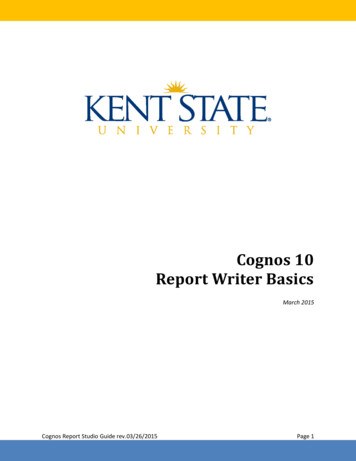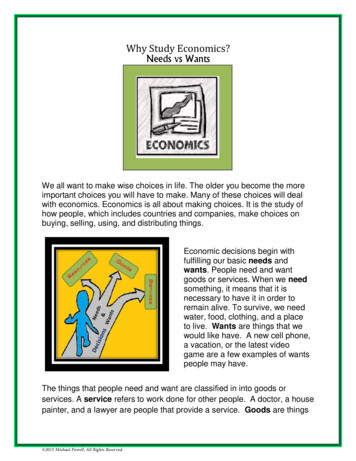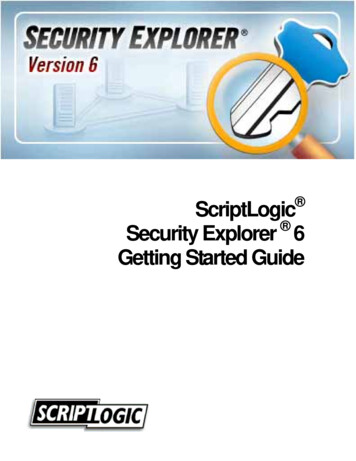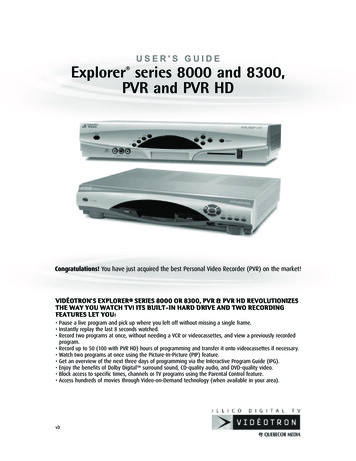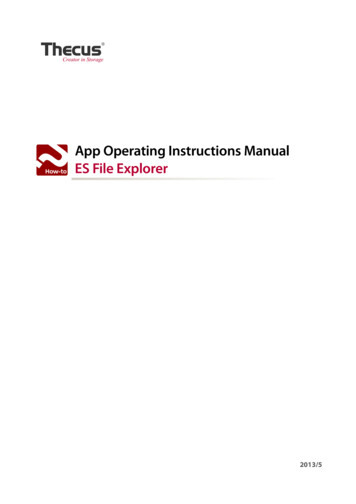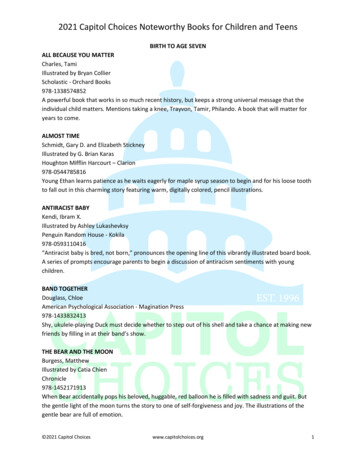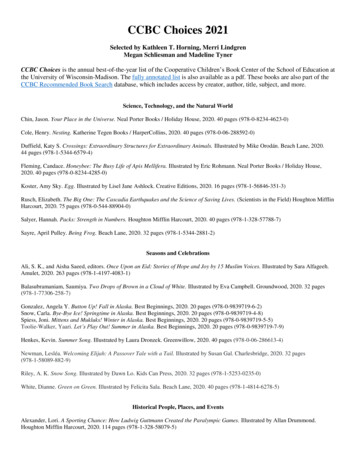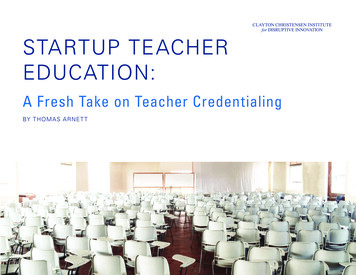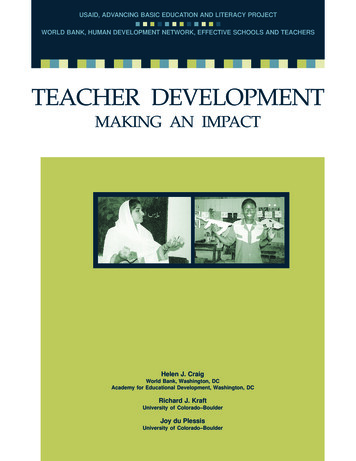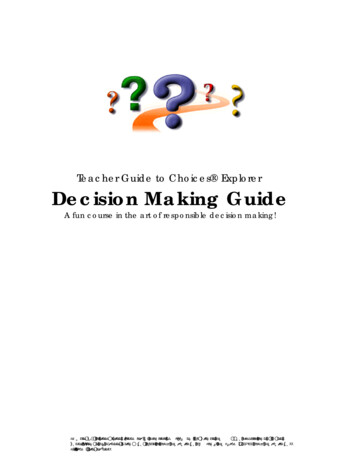
Transcription
Teacher Guide to Choices ExplorerDecision Making GuideA fun course in the art of responsible decision making!&KRLFHV LV D UHJLVWHUHG WUDGHPDUN RI &DQDGD (PSOR\PHQW ,QVXUDQFH &RPPLVVLRQ &(,& DQG LV XVHG XQGHU OLFHQVH E\ %ULGJHV 7UDQVLWLRQV ,QF D ; 3 &RUSRUDWLRQ FRPSDQ\ &RS\ULJKW ; 3 &RUSRUDWLRQ OO ULJKWV UHVHUYHG
Teacher’s Guide to the Decision Making GuidePage Teacher-2Table of ContentsTable of Contents . 2Teacher's Guide.Teacher 3Introduction. 3Teaching the Decision Making Guide to Individuals . 4Teaching the Decision Making Guide in the Classroom . 5Lesson Plans . 6Lesson One – Introduction to Decision Making . 7Lesson Two – Fortune Teller. 9Lesson Plan Three – Paths of Life . 10Paths of Life Cards. 11Lesson Plan Four – Life's Little Scenarios. 15Lesson Plan Five – Paths of Life II: The Big Picture. 18Lesson Plan Six – Responsible Decision Making: Getting Ready . 19Lesson Plan Seven – Druthers: Yer Little Town of Decisions. 20Lesson Plan Eight – My Most Amazing Life: Today's Edition . 21Worksheet: Steps to One Big Goal . 23Unit Outcomes. 24Evaluation. 24Student Decision Making Guide. Student 3What is This?. 3The “R” Word. 4Activity A: The Fortune Teller . 5Worksheet: Getting Whatever You Get. 6Fortune Teller's Room . 7Activity B: Paths of Life. 8Worksheet: Snap Decisions. 9Activity C: Life’s Little Scenarios. 10Worksheet: My Own Little Scenario . 12Activity D: Paths of Life II – The Big Picture . 13Worksheet: The Big Picture . 14Paths of Life Map . 15Activity E: Values. 16Worksheet: Decisions, Decisions. 17Activity F: Druthers – Yer Little Town of Decisions . 18Worksheet: Decision Assessment . 20Checklist . 21Printing this PDF Document?The Adobe Acrobat PDF format is ideal for downloading printer-friendly filesfrom Web sites such as Choices Explorer. To conserve paper, you do not need to printall the pages of this Decision Making Guide.Only a few pages really need to be printed and filled in as part of this course.Each page to be printed is clearly marked with a "Print This" symbol below thep age number, and is highlighted in the Table of Contents with this symbol:.PRINTTHIS!&KRLFHV LV D UHJLVWHUHG WUDGHPDUN RI &DQDGD (PSOR\PHQW ,QVXUDQFH &RPPLVVLRQ &(,& DQG LV XVHG XQGHU OLFHQVH E\ %ULGJHV 7UDQVLWLRQV ,QF D ; 3 &RUSRUDWLRQ FRPSDQ\ &RS\ULJKW ; 3 &RUSRUDWLRQ OO ULJKWV UHVHUYHG
Teacher’s Guide to the Decision Making GuidePage Teacher-3Teacher's GuideIntroductionMany people today (young and older!) have no concept of what a responsible decision really is. Mostof us just make snap decisions, or we make no choice at all – leaving future consequences to fate andwishful thinking. This unit, targeted for learners in 8th grade and up, teaches a five-step process forresponsible decision-making. The steps are:1.2.3.4.5.Identify your choicesWhat's best for you now?Consider others – Not only meConsider your future – Not only nowMake a choice and go for itMany of our life choices miss steps three and four, above, hence the title of this unit! It is ourcontention that a responsible decision is one where you consider others and your future before youdecide. You don't have to do what others want or what the future will require, you just have to considerthe implications of possible actions. By thinking beyond yourself and beyond the moment, you aremore likely to select choices that have positive social and future benefits. This would be good.&KRLFHV LV D UHJLVWHUHG WUDGHPDUN RI &DQDGD (PSOR\PHQW ,QVXUDQFH &RPPLVVLRQ &(,& DQG LV XVHG XQGHU OLFHQVH E\ %ULGJHV 7UDQVLWLRQV ,QF D ; 3 &RUSRUDWLRQ FRPSDQ\ &RS\ULJKW ; 3 &RUSRUDWLRQ OO ULJKWV UHVHUYHG
Teacher’s Guide to the Decision Making GuidePage Teacher-4Teaching the Decision Making Guide to IndividualsThe Decision Making Guide has been organized for individuals to complete at their own pace. The unitis broken down as follows:InfoSheet: The 'R' WordIntroduces learners to the unit and outlines the five steps involved in a responsibledecision.Activity A: Fortune TellerThis activity examines the advantages and disadvantages of making no decisions aboutyour future. Learners are given their future by visiting the Fortune Teller's room andthen asked how they like it.Activity B: Paths of LifeThis activity relates making 50/50 life decisions to finding employment. It alsointroduces learners to snap decisions – choices made with little or no consideration ofthe implications.Activity C: Life's Little ScenariosLearners make snap decisions about various life scenarios and then examine the impactof their choices on others. The importance of considering others when makingsignificant decisions is emphasized.Activity D: Paths of Life II – The Big PictureThis activity demonstrates the importance of considering the future when making keylife decisions.Activity E: ValuesThis activity teaches the art of selecting different decision-making strategies fordifferent situations. Learners are encouraged to take the harder – more responsible –path more often. Those paths often lead to rewards less immediate and more satisfying.Activity F: Druthers – Yer Little Town of DecisionsEight scenarios are provided from a variety of life circumstances. Learners apply thedecision-making process to each one. Each person ends the unit by applying theresponsible decision-making process to their own career and life plans.ChecklistThis resource summarizes all the products for evaluation that were developed as part ofthe unit. Students complete the checklist and use it as a cover page when submittingwork to you.The average student working independently should take six to eight hours to complete the unit.&KRLFHV LV D UHJLVWHUHG WUDGHPDUN RI &DQDGD (PSOR\PHQW ,QVXUDQFH &RPPLVVLRQ &(,& DQG LV XVHG XQGHU OLFHQVH E\ %ULGJHV 7UDQVLWLRQV ,QF D ; 3 &RUSRUDWLRQ FRPSDQ\ &RS\ULJKW ; 3 &RUSRUDWLRQ OO ULJKWV UHVHUYHG
Teacher’s Guide to the Decision Making GuidePage Teacher-5Teaching the Decision Making Guide in the ClassroomOne classroom strategy is simply to have a class of students use the Decision Making Guide on thecomputer and have them complete the unit individually. We believe this should be your second choice.It is our contention that these units are just tools. They are made most useful by teachers who use themskillfully. Suggested classroom lessons are included with this Teacher's Guide.If you do not have access to a classroom of computers to teach this unit, the lesson plans also includelinks to worksheets to develop related classroom activities.We encourage you to integrate or develop additional resources to make the decision-making unit evenmore interesting and enjoyable for young learners. The skill of responsible decision making is critical totheir future success. We want to make the unit meaningful – using whatever resources we can! Pleaselet us know of any novel ideas you have, and we'll pass them on to other users.The major reason for the scarcity of responsible decisions in anyone's life is that a responsible decisionusually has delayed gratification. We're all just a little too impatient sometimes for the arrival of theeventual reward – especially when there are no guarantees that we'll get one! Thinking "not only me,not only now" is hard to do. It also is imperative in quality career and life planning. If we all keeppushing this concept, and model the process ourselves in our own daily lives, we will see more of ourstudents making a successful transition to a healthy, happy, self-reliant life.&KRLFHV LV D UHJLVWHUHG WUDGHPDUN RI &DQDGD (PSOR\PHQW ,QVXUDQFH &RPPLVVLRQ &(,& DQG LV XVHG XQGHU OLFHQVH E\ %ULGJHV 7UDQVLWLRQV ,QF D ; 3 &RUSRUDWLRQ FRPSDQ\ &RS\ULJKW ; 3 &RUSRUDWLRQ OO ULJKWV UHVHUYHG
Teacher’s Guide to the Decision Making GuidePage Teacher-6Lesson PlansLesson OneLesson TwoLesson ThreeLesson FourLesson FiveLesson SixLesson SevenLesson EightIntroduction to Decision-MakingFortune TellerPaths of LifeLife's Little ScenariosPaths of Life II – The Big PictureResponsible Decision-Making – Getting ReadyDruthers – Yer Little Town of DecisionsMy Most Amazing Life – Today's Edition&KRLFHV LV D UHJLVWHUHG WUDGHPDUN RI &DQDGD (PSOR\PHQW ,QVXUDQFH &RPPLVVLRQ &(,& DQG LV XVHG XQGHU OLFHQVH E\ %ULGJHV 7UDQVLWLRQV ,QF D ; 3 &RUSRUDWLRQ FRPSDQ\ &RS\ULJKW ; 3 &RUSRUDWLRQ OO ULJKWV UHVHUYHG
Teacher’s Guide to the Decision Making GuidePage Teacher-7Lesson One – Introduction to Decision MakingPurposeTo introduce students to the three types of decision making: no decision, snap decisions, andresponsible decisions.Outcomes1. Students will identify three types of decision making.2. Students will relate responsible decision making with effective career and life planning.3. Students will be able to outline the Decision Making Guide and evaluative structure.Materials and Prepx Get a guest speaker to outline at least five key decision points in their life. These should bedecisions (or non-decisions!) that shaped their life. (10 minutes)x Prepare a Unit Outline and an Evaluation Outline – your own unique way of presenting andevaluating the unit.Introductory Activityx Ask students to identify 50 decisions a person can make in their life – for example, what cerealto eat, what to do on the weekend, what career goals to pursue. Go around the room one at atime, placing answers on board.x Define three types of decisions for students, and have them record them in their notes. Theyare:No Decision – Letting others decide what you will do.Snap Decision – A quick choice you make with no consideration of the result.Responsible Decision – Considering others (Not only me) and your future (Not onlynow) when you make a decision.x Ask students to individually place the 50 decisions on the board into one of those threecategories. They do this by listing the three decision types on the top of their page, and listingthe choices in the appropriate column.x Have students compare their lists to the lists of two other students. Bet them that no one has thesame list!x Inform students that the next eight classes will focus on developing skills for responsibledecision making. We'll begin with a look at No Decision as a decision-making strategy.&KRLFHV LV D UHJLVWHUHG WUDGHPDUN RI &DQDGD (PSOR\PHQW ,QVXUDQFH &RPPLVVLRQ &(,& DQG LV XVHG XQGHU OLFHQVH E\ %ULGJHV 7UDQVLWLRQV ,QF D ; 3 &RUSRUDWLRQ FRPSDQ\ &RS\ULJKW ; 3 &RUSRUDWLRQ OO ULJKWV UHVHUYHG
Teacher’s Guide to the Decision Making GuidePage Teacher-8Lesson One – Introduction to Decision Making (cont.)Development ActivitiesGuest SpeakerIntroduce your guest speaker, who you have prepared to give a 10-minute presentationabout key decision points in their life. (Plan B would be for you to do this about yourown life!) The main objective of the presenter is to show the implications of lifedecisions – responsible or not. Students should conclude that some decisions in lifeshould be well thought out.Unit OverviewHand out an overview (that you've developed) of your Decision Making Guide. Reviewit with students. Indicate which classes are in the computer lab and which are not.Evaluation OverviewClearly define what will be assessed and how it will be evaluated. Outline yourevaluation structure and weighting. Review the content and criteria for each assignmentbriefly and outline the timeline for assignment completion.Reflective LearningAsk students to write a one-paragraph summary of their preferred method for makingdecisions. Ask them to explain at least three reasons why it is their preferred style.NOTE: This is to be submitted as part of the Reflective Thinking assignment, which isturned in at the end of the unit.&KRLFHV LV D UHJLVWHUHG WUDGHPDUN RI &DQDGD (PSOR\PHQW ,QVXUDQFH &RPPLVVLRQ &(,& DQG LV XVHG XQGHU OLFHQVH E\ %ULGJHV 7UDQVLWLRQV ,QF D ; 3 &RUSRUDWLRQ FRPSDQ\ &RS\ULJKW ; 3 &RUSRUDWLRQ OO ULJKWV UHVHUYHG
Teacher’s Guide to the Decision Making GuidePage Teacher-9Lesson Two – Fortune TellerPurposeTo examine making "no decision" about your future.Outcomes1. Students will state an opinion about life with no choices – you never have to be responsible!2. Students will define the four key aspects that must be managed in a person's career.3. Students will identify the advantages and disadvantages of having decisions about your lifemade for you.Materials and Prepx Access to a computer lab, featuring Bridges' Decision Making Guide.x A classroom set of the worksheet Getting Whatever You Get.Introductory ActivityLecture: Tell students that the word 'career' doesn't mean what it used to. It used to mean 'work'; now itmeans anything you do in your life. Tell them there are four main aspects to a career. They are:x x x x WorkRecreationRelationshipsLifelong Learning – This is important! It is the source of vitality, energy, enthusiasm,personal growth Throughout life, you have to manage these four things, because youcan't do all of them well. (You can probably do about two-and-a-half of them well!)Tell students that because we can't have everything we want in these four areas, wehave to make decisions.Wouldn't it be great if we didn't have to make decisions? If you never make any choices, you're notresponsible for anything. Tell students that the next exercise is designed to see what it would be like if aFortune Teller gave you your future – and you wouldn't have to decide a thing!Development ActivitiesFortune TellerTake students through Activity A – Fortune Teller. In a whole class discussion, askstudents to identify good things about the lifestyle they've been given. Ask them toidentify problems.Getting Whatever You GetHave students discuss the questions of this worksheet in class. Ask them how many arehappy with the lifestyle that the Fortune Teller gave them. Once a group discussion isfinished, have them complete their written answers on the worksheet.Reflective LearningGive students this assignment: In a one-paragraph summary, write what you wouldthink if your future was decided by others or by fate. Supply at least three reasons whyyou answered as you did. This is to be submitted as part of the Reflective Thinkingassignment, which is turned in at the end of the unit.&KRLFHV LV D UHJLVWHUHG WUDGHPDUN RI &DQDGD (PSOR\PHQW ,QVXUDQFH &RPPLVVLRQ &(,& DQG LV XVHG XQGHU OLFHQVH E\ %ULGJHV 7UDQVLWLRQV ,QF D ; 3 &RUSRUDWLRQ FRPSDQ\ &RS\ULJKW ; 3 &RUSRUDWLRQ OO ULJKWV UHVHUYHG
Teacher’s Guide to the Decision Making GuidePage Teacher-10Lesson Plan Three – Paths of LifePurposeTo examine the impact of Snap Decisions on a life.Outcomes1. Students will define several benefits of and problems with snap decisions.2. Students will explain why snap decisions are more common than responsible decisions.3. Students will relate personal needs, interests, and skills to the process of making decisions.Materials and Prepx Access to a computer lab with Bridges Initiatives' Decision Making Guide or use paper cards tocreate a classroom activity for the Paths of Life.x Look over the process of the Paths of Life exercise. Some students will have questions aboutsome of the choices the SECOND time they go through it. If you have resources to help themget an answer, bring those resources to class.x A classroom set of the worksheet Snap Decisions.Introductory Activityx Tell students that last day we looked at the decision-making style of No Decision – a style thatis preferred by some people who either don't want responsibility or don't care what happens totheir life. Today, we will examine a second decision-making style – Snap Decisions. Remindthem of the definition.x Ask students to identify snap decisions they made in the past 24 hours – for example, what shirtto wear, what TV show to watch, what person to phone. Inform them that many life situationsare best dealt with by a snap decision. Today's activity will examine the benefits and problemsof snap decision-making.Development ActivitiesPaths of LifeLet students play with Activity B in the Decision Making Guide. Inform them there will be aclass discussion today, after they have completed the Snap Decisions Worksheet.Class DiscussionAsk each student which career they ended up with the FIRST time they went through theactivity. Repeat the exercise with the SECOND career they ended up in – when they took alittle time to think of their needs, interests and skills before they decided. Finally, ask whopreferred their second to their first career. Ask why they preferred the one they did.Focus on student opinions from question four of the Snap Decisions Worksheet. Hopefully,they will conclude that snap decisions only satisfy immediate wants and needs, and that adifferent decision-making style is required for effective future planning!Reflective LearningAsk students to write on a sheet of paper three things they have learned in the past threelessons. This is to be submitted as part of the Reflective Thinking assignment, which is turned inat the end of the unit.&KRLFHV LV D UHJLVWHUHG WUDGHPDUN RI &DQDGD (PSOR\PHQW ,QVXUDQFH &RPPLVVLRQ &(,& DQG LV XVHG XQGHU OLFHQVH E\ %ULGJHV 7UDQVLWLRQV ,QF D ; 3 &RUSRUDWLRQ FRPSDQ\ &RS\ULJKW ; 3 &RUSRUDWLRQ OO ULJKWV UHVHUYHG
Teacher’s Guide to the Decision Making GuidePage Teacher-11Lesson Plan Three – Paths of LifePaths of Life CardsThis exercise is suggested for teachers unable to use the Decision Making Guide in a computer labenvironment.Print the 30 Paths of Life cards and cut them out. Each has information related to making choices. Placethe cards on desks or chairs in your classroom. Each card offers two choices, or provides one possibleresult of choices made earlier in the activity.Put students through the path one at a time, starting with the Path of Life card. At the end, each studentstands at the card where they ended up.Use this structure to follow the same training routine outlined in Activity B and Activity D.&KRLFHV LV D UHJLVWHUHG WUDGHPDUN RI &DQDGD (PSOR\PHQW ,QVXUDQFH &RPPLVVLRQ &(,& DQG LV XVHG XQGHU OLFHQVH E\ %ULGJHV 7UDQVLWLRQV ,QF D ; 3 &RUSRUDWLRQ FRPSDQ\ &RS\ULJKW ; 3 &RUSRUDWLRQ OO ULJKWV UHVHUYHG
PRINTTHIS!Teacher’s Guide to the Decision Making GuidePage Teacher-12Paths of Life CardsPath of LifeYou have just graduated from high school.You have two choices: to take a learning paththat has a total learning focus (no income), or alearning path than places an equal focus onwork and learning (some income). Which doyou choose?Four-Year University FocusYou have a choice. You can elect to take aBachelor of Science degree (for example,physics, chemistry, biology, math) or a Bachelorof Arts degree (for example, English, history,geography, political science, psychology).You have a choice. You can elect full-time fullpay work – getting your education from whatyou learn in day-to-day life – or you can chooseto take an educational program where youcombine paid work with non-paid learning.You have a choice. You can elect to take afour-year university program leading to adegree, or you can choose a two-yeartechnical school program leading to a diploma.Two-Year Technical School ProgramFull-Time Full-Paid WorkYou have a choice. You can elect to take aComputer Tech diploma program or a HealthTech diploma program.You have a choice. You can take employmentworking for someone else (also known as a job!)or you can open your own business, working foryourself.Combined Paid Work andNon-Paid Learning ProgramYou have a choice. You can enrol in anApprenticeship Program (trades and technicalfocus) or you can enrol in a CooperativeEducation Program (academic or technicalschool education with built-in related summeremployment) at a college or university.&KRLFHV LV D UHJLVWHUHG WUDGHPDUN RI &DQDGD (PSOR\PHQW ,QVXUDQFH &RPPLVVLRQ &(,& DQG LV XVHG XQGHU OLFHQVH E\ %ULGJHV 7UDQVLWLRQV ,QF D ; 3 &RUSRUDWLRQ FRPSDQ\ &RS\ULJKW ; 3 &RUSRUDWLRQ OO ULJKWV UHVHUYHG
Teacher’s Guide to the Decision Making GuidePage Teacher-13Bachelor of ScienceDegreeBachelor of ArtsDegreeComputer TechProgramYou have a choice.You can pursue yourscience degree inphysics or in biology.Which do youprefer?You have a choice.You can get yourBachelor of Artsdegree inpsychology or inEnglish. Which doyou prefer?You have a choice.You can get yourdiploma in computersystems managementor computer-assisteddrafting. Which do youprefer?Health Tech ProgramYou have a choice.You can get yourdiploma in radiologyor you can becomequalified in medicallaboratorytechnology. Whichdo you prefer?Work For Someone ElseWork For YourselfYou have a choice. Two job opportunities havebeen presented to you – one in travel andtourism and the other in banking. Which do youprefer?You have a choice. You can put your efforts intodeveloping a new business, or you can inventsomething new and try to sell it. Which do youprefer?Apprenticeship ProgramCooperative Education ProgramYou have a choice. You can go afteremployment in the world of builders or in theworld of technology. Which type ofapprenticeship program would you prefer?You have a choice. You can take your co-optraining in business administration or inenvironmental studies. Which do you prefer?EnglishBiologyCongratulations – you're working as a newsreporter for a local radio station! You check outevents in your community (get some good dirt!),and then write and report the story on the radio.You have to check out information to ensure it iscorrect, especially if the story will influence otherpeople's lives! You interview people, do a lot ofresearch, and write stories that are short andinteresting for your radio listeners. The peopleyou work with thought your story about Hunter'sPantyhose was a little off-the-wall, especiallywhen you ended it with the jingle "When theterrain gets rough, this hose hangs tough!"Congratulations – you are a geneticist! You areworking on the leading edge of gene splicingand cloning and other stuff dealing withinherited traits in humans. You performexperiments with plant or animal materials andfigure out how to create new things fromgenetic matter. You're kind of like Dr.Frankenstein, only with a cleaner lab coat and aless evil laugh! Through your extensive research,financed by a government grant, youconcluded that (and we quote) "If your parentsdidn't have any children, it is highly unlikely thatyou will have any either." Brilliant!PhysicsPsychologyCongratulations on becoming a geophysicist!You analyse and assess the movements of theearth to determine where earthquakes are likelyto happen. You look into gravity, theatmosphere, volcanic stuff, disaster prevention –you've really got a neat job! You are the gravityguru who first concluded that the earth sucks.Congratulations! Your choices have led you to acareer as a child psychologist! You use tests,interview techniques, and good observation tohelp children who are having difficulties in theirlives. Sometimes you do some work with thefamily to figure out or solve the problem. You areconsidering opening a Cowboy Crisis Line, forlonesome cowpokes who feel guilty abouthaving punched cows for so long. Don't wait up.&KRLFHV LV D UHJLVWHUHG WUDGHPDUN RI &DQDGD (PSOR\PHQW ,QVXUDQFH &RPPLVVLRQ &(,& DQG LV XVHG XQGHU OLFHQVH E\ %ULGJHV 7UDQVLWLRQV ,QF D ; 3 &RUSRUDWLRQ FRPSDQ\ &RS\ULJKW ; 3 &RUSRUDWLRQ OO ULJKWV UHVHUYHG PRINTTHIS!
Teacher’s Guide to the Decision Making GuidePage Teacher-14&KRLFHV LV D UHJLVWHUHG WUDGHPDUN RI &DQDGD (PSOR\PHQW ,QVXUDQFH &RPPLVVLRQ &(,& DQG LV XVHG XQGHU OLFHQVH E\ %ULGJHV 7UDQVLWLRQV ,QF D ; 3 &RUSRUDWLRQ FRPSDQ\ &RS\ULJKW ; 3 &RUSRUDWLRQ OO ULJKWV UHVHUYHG PRINTTHIS!
Teacher’s Guide to the Decision Making GuidePage Teacher-15Medical Laboratory TechnologyRadiologyCongratulations! You're a lab technician workingin medical research, looking into the causes ofdeadly diseases like cancer and AIDS. Beforegetting this job you worked in a regular lab,assessing blood and other body fluids for thepresence of health problems and illness. You didblood counts and even developed vaccines foruse by doctors. Now you do more work inresearch with human tissues and body cells. Youwear a lab coat, and dream of being the firstperson to discover the gene for human shyness,which you know will be hiding behind anothergene.Congratulations on becoming an x-raytechnician! Yours is the only job in the world thatstarts with the letter X – and even this group nowcalls itself 'radiologic technicians'! Your job is touse x-ray technology to help figure out what'swrong with people suffering from disease orinjury. You also get involved in radiation therapy,using the technology for medical treatment. LikeSuperman, you've never used your x-ray talentsfor personal gain, although you did once noticethat a patient had a heart of gold!Business AdministrationEnvironmental StudiesCongratulations! You've used your co-optraining to become a tax accountant with alocal accounting firm. You help people andbusinesses with their income tax returns, makingfriends all the way as you help them tounderstand the rules of taxation! You alsoprovide advice to businesses on how to get thebest tax benefits for their companies. You'vedeveloped a new and more effective tax formfor the government – it's just two lines. First line:How much money did you make last year?Second line: Send it in.Congratulations on becoming a water qualitytechnologist! You use technical equipment toassess the quality of drinking water in city andcountry areas. You research the source of anypollutants in the water and report your findings.You used your co-op placement to get a jobwith the government. Your next task is toevaluate the impact of a local industry'spollutants on wildlife and water quality. The onlything you don't like about your job is that yourneighbor won't stop sa
This activity relates making 50/50 life decisions to finding employment. It also introduces learners to snap decisions – choices made with little or no consideration of the implications. Activity C: Life's Little Scenarios Learners make snap decisions about various life scenarios and then examin
